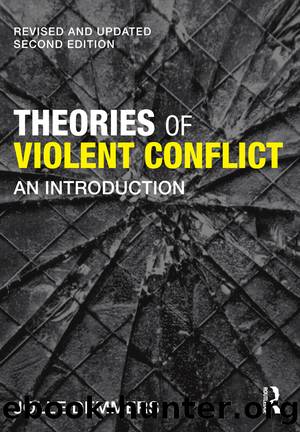Theories of Violent Conflict by Jolle Demmers

Author:Jolle Demmers [Jolle Demmers]
Language: eng
Format: epub
Publisher: Routledge
The three questions
Let us now turn to the three core questions of the book to try and assess structure-based approaches to violent conflict. Again, we are forced to simplify a rather diverse and broad research tradition, and the answers to the three questions are clearly not unequivocal. However incomplete, the answers below do bring out a series of stark contrasts with those of the earlier chapters on ethnic boundaries and social identities. The most obvious contrast pertains to our first question: What makes a group? It is unsurprising that structure-based approaches do not indulge in long elaborations of what makes the individual or collective agent, for, as has been emphasized enough, they place the sources of violent conflict at the level of structures, not agents. Almost by implication, the group formations in zones of conflict do not fall in line with what Marxian approaches recognize as the ‘real’ parties in conflict. The ‘real’ groups in conflict are produced by the contradictions in the structure of the system. What is suggested by, for instance, the work of Galtung, and many of the authors in the critical political economy tradition, is that groups are individuals who share a similar position in the market economy. The dominant idea here is that of people having clearly defined interests. However, often people do not act in accordance with these interests (or, as in Galtung, they have no awareness of their joint exploitation). They fail to see what it is that is standing in their way. Their social anxieties and frustrations are projected onto ‘false’ enemies and threats, and hence translate into unrealistic forms of violence. The resulting conflict formations and violent actions in no possible way address, let alone resolve, the fundamental contradictions underlying them. It is this distinction between realistic and unrealistic violence which sets the structure-based approaches apart from other theoretical approaches to violent conflict. Even if people are aware of ‘true contradictions’, their room to manoeuvre is extremely limited and constrained by institutions, laws and regulations. Ontologically, structure-based approaches support a holistic stance. Holists contend that power resides in institutions and as such is beyond the control of the individual. People have little choice but to act according to the constitutive and regulative rules of the dominant social order. Particularly the orderings of the state (citizenship status, immigration laws), capitalism (financialization, consumption, production, job market, salaries) and global governance (international law and institutions, security doctrines, imperial powers) create robust and inescapable ‘facts of life’ that defy change. As long as the inherent contradictions in the organization of the modern state system, global capitalism and global governance remain, the violence that comes with them, both structural and direct, will remain as well.
The connection between structures and violence runs through the state. The fundamental contradictions in the structures of the modern state system, capitalism and global governance produce incompetent states that cannot accommodate needs and demands from society. This is the basic problem underlying contexts of instability and expulsion, which then translate into identity conflicts, network wars and social control states.
Download
This site does not store any files on its server. We only index and link to content provided by other sites. Please contact the content providers to delete copyright contents if any and email us, we'll remove relevant links or contents immediately.
Cecilia; Or, Memoirs of an Heiress — Volume 1 by Fanny Burney(32503)
Cecilia; Or, Memoirs of an Heiress — Volume 2 by Fanny Burney(31913)
Cecilia; Or, Memoirs of an Heiress — Volume 3 by Fanny Burney(31900)
The Great Music City by Andrea Baker(31761)
We're Going to Need More Wine by Gabrielle Union(19004)
All the Missing Girls by Megan Miranda(15788)
Pimp by Iceberg Slim(14440)
Bombshells: Glamour Girls of a Lifetime by Sullivan Steve(14024)
For the Love of Europe by Rick Steves(13643)
Talking to Strangers by Malcolm Gladwell(13300)
Norse Mythology by Gaiman Neil(13284)
Fifty Shades Freed by E L James(13189)
Mindhunter: Inside the FBI's Elite Serial Crime Unit by John E. Douglas & Mark Olshaker(9267)
Crazy Rich Asians by Kevin Kwan(9225)
The Lost Art of Listening by Michael P. Nichols(7456)
Enlightenment Now: The Case for Reason, Science, Humanism, and Progress by Steven Pinker(7275)
The Four Agreements by Don Miguel Ruiz(6704)
Bad Blood by John Carreyrou(6586)
Weapons of Math Destruction by Cathy O'Neil(6221)
